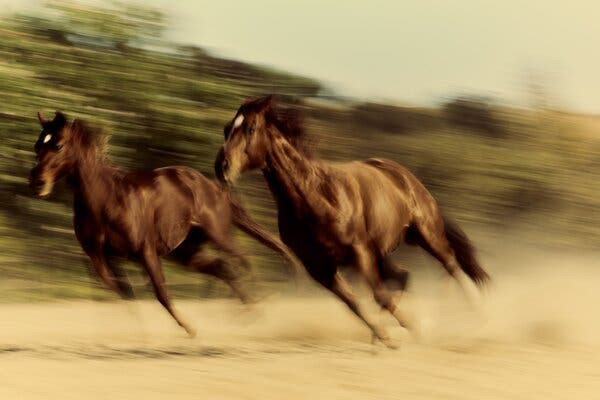
Horses are exquisite machines. As prey animals, their greatest survival tools are designed for flight, and every sense is finely geared toward safety. In the wild, they spend the entirety of their lives within the eyesight of another horse. Even domestic horses who don’t venture beyond their pasture will take turns staying awake while others sleep. They can see nearly 360 degrees and can focus on two objects at once, one from each eye. They evolved to mosey along, grazing for up to 16 hours a day, using whiskers on their muzzle to discern, in part, tender grass from rocks. Their hide is so sensitive to touch that they can feel a single fly land on their body and wriggle the skin underneath to send it aloft. Their sense of smell is almost as keen as a dog’s.
Horses form friendships, and friends stand nose to rump to cooperatively swish flies from the other’s face with their tails. They’ll rake their teeth against the other’s withers or back, scratching places the other cannot reach on his own. Where our brains are outfitted with a prefrontal cortex that allows for planning, organizing, setting goals and decision making, a horse has virtually none. They experience thoughts and emotions without the benefit of evaluation, and although they can remember a great deal, they don’t think about what they want to do tomorrow, which makes them geniuses at living in the present. Since they fear they may die without the collective protection of the group, they are experts at coexisting. They just want to get along.

In the roughly 5,500 years since their domestication, horses have continuously been in our service, whether it’s to charge into battle; race chariots; hunt buffalo; bust sod; carry the mail; run, leap and pull at our bidding; or, more recently and mundanely, tote kids around a ring in a county 4-H show. Despite this long and intimate association, interspecies communication can be tricky, and things between horses and people don’t always go so well. Horses can shy or bolt. They can buck, bite or plant their feet and refuse to go forward. Frustration, for both horse and owner, can begin to build, and with it grows the possibility for getting hurt.
That’s where trainers like Warwick Schiller come in, bridging the knowledge gap between people and their mounts. His methods for improving steering or loading a reluctant horse into a trailer weren’t too different from those of the rest of the horse world. Lots of folks can teach an anxious horse to achieve a more relaxed state of mind by circling to a stop, or to keep a steady pace within a gait. And horses, they’re the same everywhere, generally willing to try to do what a person demands, even if the request is clumsy. “Horses in the wild show almost no infirmity,” Schiller explains. “They’re good at pretending they’re OK. They’ll take a lot of heavy-handed training, and a lot of people with horses are fine with that. The horses still work for them.”